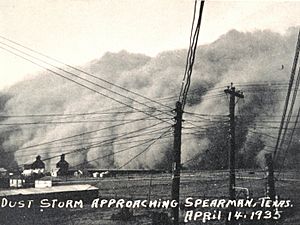Black Sunday (storm) facts for kids
Black Sunday was a super strong dust storm that happened on April 14, 1935. It was part of a tough time called the Dust Bowl in the United States. This storm was one of the worst ever in American history. It caused huge problems for farms and the economy. Experts think it blew away about 300,000 tons of rich topsoil from the prairie lands.
On the afternoon of April 14, people in several plains states had to find shelter. A massive dust storm, also called a "black blizzard," swept through the area. The storm first hit the Oklahoma panhandle and northwest Oklahoma. Then, it moved south for the rest of the day. It reached Beaver, Oklahoma around 4 p.m. It hit Boise City around 5:15 p.m. and Amarillo, Texas by 7:20 p.m. The worst conditions were in the Oklahoma and Texas panhandle areas. But other nearby places also felt the storm's effects. A mix of dry weather, soil erosion, bare ground, and strong winds made the dust fly fast and freely.
Contents
What Was the Dust Bowl?
The "Dust Bowl" first described many dust storms. These storms hit the prairies of Canada and the United States in the 1930s. Now, the name also refers to the area in the U.S. most affected by these storms. This area includes western Kansas, eastern Colorado, northeast New Mexico, and the Oklahoma and Texas panhandles. The "black blizzards" began in the eastern states in 1930. They harmed farms from Maine to Arkansas. By 1934, they had reached the Great Plains. This huge area stretched from North Dakota to Texas. It went from the Mississippi River Valley to the Rocky Mountains. The Dust Bowl region got its name after the terrible Black Sunday storm in April 1935. A reporter named Robert E. Geiger called the region "the Dust Bowl" in his story about the storm.
Why Did the Dust Bowl Happen?
Before the Dust Bowl, lots of cattle and sheep farming had removed natural grass and shrubs. These plants usually help hold the soil in place. Also, too much farming and poor soil care left the soil very dry. It didn't have enough healthy stuff in it. A drought hit the United States in the 1930s. This meant very little rain, snow, or moisture in the air. This dried out the topsoil in most of the country's farming regions.
How Did Black Sunday Affect People?
The dust storms, especially Black Sunday, caused a lot of damage. Several people died. Hundreds of thousands of people had to leave their homes. Poor families from the American Southwest moved to California. They were often called "Okies," even though only about 20% were from Oklahoma. Their arrival put a big strain on California's health and job services.
After the huge damage from these storms in 1935, Congress passed a new law. It was called the Soil Conservation Act. This law created the Soil Conservation Service (SCS). It became a permanent part of the USDA. The SCS was made to help landowners and farmers. Its goal was to reduce soil erosion. It also aimed to improve forests and farmlands. Plus, it worked to save and develop natural resources. This led to a big project called the Great Plains Shelterbelt.
Stories from the Dust Bowl
During the 1930s, many people living in the Dust Bowl kept journals. They wrote about their lives and the storms. Collections of these stories have been put together over the years. You can find them in books and online.
"People caught in their own yards grope for the doorstep. Cars come to a standstill, for no light in the world can penetrate that swirling murk…. The nightmare is deepest during the storms. But on the occasional bright day and the usual gray day we cannot shake from it. We live with the dust, eat it, sleep with it, watch it strip us of possessions and the hope of possessions."
—Avis D. Carlson, The New Republic
Lawrence Svobida was a wheat farmer in Kansas during the 1930s. He saw the dust storms firsthand. He also saw how they changed the land and the people. His thoughts and feelings are in his book, Farming the Dust Bowl. Here is how he described a dust storm coming:
"… At other times a cloud is seen to be approaching from a distance of many miles. Already it has the banked appearance of a cumulus cloud, but it is black instead of white and it hangs low, seeming to hug the earth. Instead of being slow to change its form, it appears to be rolling on itself from the crest downward. As it sweeps onward, the landscape is progressively blotted out. Birds fly in terror before the storm, and only those that are strong of wing may escape. The smaller birds fly until they are exhausted, then fall to the ground, to share the fate of the thousands of jack rabbits which perish from suffocation."
The Black Sunday storm is also shown in a 2012 TV show. It's a PBS documentary by Ken Burns called The Dust Bowl.


